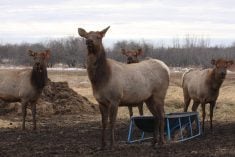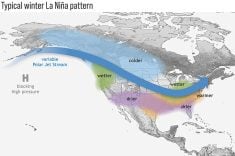Manitoba farmers seeded 65,000 acres of field peas in 2017.
This year that number more than tripled, as Manitoba growers planted 225,000 acres of peas.
Pea acres may climb even higher in 2022 because many growers want to avoid nitrogen-dependent crops like wheat, canola and corn.
“They see that fertilizer prices are high. (Peas) don’t need nitrogen. They see there is some good pricing,” said Anastasia Kubinec, an agronomist with Roquette Canada, which operates a pea protein plant in Portage la Prairie, Man.
The Roquette plant, the largest pea protein facility in the world, officially opened this fall. The plant has rejuvenated pea production in Manitoba. It has the capacity to process 125,000 tonnes of peas annually.
Read Also

Saskatchewan throne speech promises strong economy
Saskatchewan’s legislative agenda for the coming year will focus on meeting the challenges of new world trading relationships, said the speech from the throne.
“We see this as a transformational event in our history and a boost to the global plant-based food sector,” said Pierre Courduroux, Roquette chief executive officer, in November.
More growers may try peas in 2022 to supply Roquette and other buyers, but many farmers could be unfamiliar with the crop.
It’s possible they’ve never grown peas before, or the last time was 2002.
“With these huge increase in pea acres, we have a lot of pea growers that are not pea growers,” said Kubinec, who shared tips on growing peas during a presentation at the Manitoba Agronomists’ Conference. The virtual event was held Dec. 15-16.
Kubinec’s first piece of advice was plant stands.
Growers should be targeting stands with six to eight live plants per sq. foot.
If farmers can achieve seven plants per sq. foot in the spring, yields could be 10-15 bushels higher in August.
“Poor live plant stands — that was the biggest issue I saw this year. Our more common plant stand was probably five,” Kubinec said.
To achieve a consistent stand of six to eight pea plants per sq. foot, growers need to think about seeding rate and what that means for a potential plant stand. As well, consistent seeding depth is critical for germination and plant emergence.
“That (seeding depth) was probably one of the biggest contributors… to whether or not plants came out of the ground (in 2021),” Kubinec said, noting most growers shoot for a depth of 1.5 to two inches.
“But (this year) I did see a lot of seeds sitting at an inch or half of an inch…. That really showed up in the field. We saw those (shallow) seeds germinating in August, when the rain came.”
Besides plant stands, Kubinec also emphasized:
- Inoculation
- Herbicide carry over
- Root rot diseases like aphanomyces
Fields where peas haven’t been grown for years need an inoculant so the plants can form nodules on the roots and fix nitrogen from the atmosphere.
“Uncertainty over surviving rhizobia levels (in the soil) and the effectiveness of native populations or surviving strains at facilitating N2 fixation, supplementary inoculant is a cost-effective way to ensure maximum fixation and yield,” says the Manitoba Pulse and Soybean Growers website.
There are different inoculant options, but the data favours granular products.
“Whether your soils are dry or wet, that granular seems to be more resilient,” she said, noting that first-time pea growers should consider double inoculation to get “the nodulation off to a good start.”
Another agronomic issue is herbicide persistence in the soil. The leftover herbicide could hinder the pea crop of 2022.
“We saw (the effects) in 2021. So, we’re really recommending that if the following products were applied in 2021, do not plant peas (on that field) in 2022,” said Kubinec, who provided a list of herbicides that could damage peas:
- Products with the active ingredient of clopyralid (brand names like Eclipse and Lontrel)
- Products with flucarbazone (Everest, Inferno Trio)
- Products with pyrasulfotole (Tundra, Velocity M3 or Infinity products)
Kubinec also discussed aphanomyces, a root rot disease in pea and lentil crops. In wet years, a severe infection of aphanomyces can reduce pea yields by 70 percent.
“Long-lived resting spores, the absence of genetic resistance, and the lack of control options make aphanomyces root rot a difficult disease to manage,” said the Saskatchewan Pulse Growers website, noting disease spores can remain in the soil for more than a decade.
Aphanomyces is less of a problem in Manitoba than in Saskatchewan because peas and lentils remain minor crops in Manitoba. But aphanomyces is in southwestern Manitoba and is popping up in other parts of the province.
“In 2021, it was confirmed in a field near Swan River and another one near Arborg,” Kubinec said. “The prevalence of this disease is going to increase as we grow more peas.”
For now, most farmers can grow peas on a four- or five-year rotation, but that would need to be extended to six to eight years if aphanomyces takes hold in Manitoba.
















